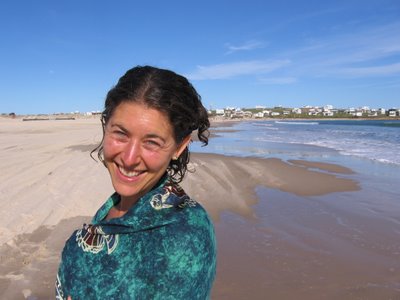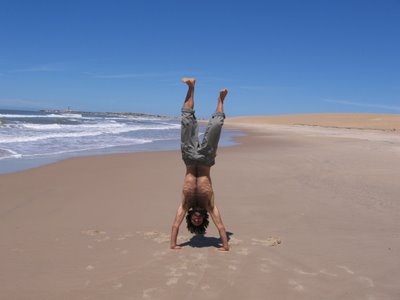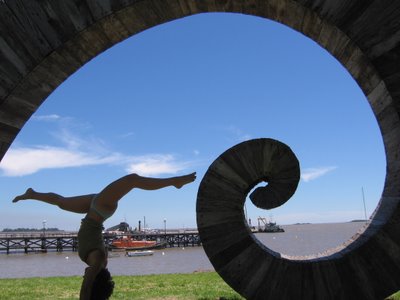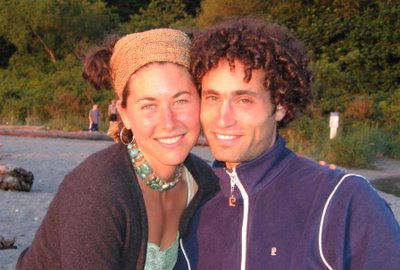wild

Cabo Polonio is wild: atlantic waves crash over rocks and sea lions lounging at the base of a defiant lighthouse. The wrecked remains of 16th century ships lie just below the waters surface. The sun and wind are both strong, but since it is a cape, one of the beaches was always sheltered. From the point, we could walk three hours in either direction down beaches empty but for the shockingly numerous dead sea creatures. (We saw, on one afternoon's stroll, 6 sea lions in varying states of decomposition,

2 penguins, a bunch of birds, dozens of fish, and even a sea tortoise - taking its final breath as we sat with it.)
We spent a week sharing a sweet pink house with good people - paying cheaper rent in exchange for some work, which basically meant we cooked a meal a day for matias and laura, who themselves had just got back from 3 months traveling in Argentina (and surely enjoyed the fresh sprout salads, spanish rice, fresh eggs ala polonio, and the soaked flax seed dessert.)
The Uruguayan town itself is picturesque: sand dunes surrounding a green wetlands of tilting hand-built houses centered around the towering lighthouse. Animals and people run free in Polonio; especially now. Just emerging from a long cold isolated winter, there are none of the

hipster summer crowds who come in from montevideo and buenos aires. Artesans with dready children and solo recluses emerge into the sunny days to gather at
el templao - the frontier-style general store, where you can buy anything: wine out of a giant cask

, aging meats on hooks, home-made egg liquor, batteries, bread...
Since no cars are allowed in town, the streets are paths of sand through the tough grass and amiable dogs are pedestrians. Cabo polonio was beautiful, but ultimately exhausting and strange: a place where the horses are like dogs, running free and frolicking in packs; the dogs are like little boys, grinning and joining you for a beach walk; and the boys are like little men, gathered on the beach in earnest conversations.

One our way back to Buenos Aires, we spent a few days in Colonia, just across the Rio de la Plata from Argentina. It's a beautiful little town, cobbled streets and colonial architecture. Here's Tamara on the waterfront perfecting her hand stands.
iguazu!




huge.
iguazu was utterly overimpressive. nearly impossible to take in the reality of its scope. the power of the wind and the volume and the sheer weight of the water as it plummetted 1000 ft was awesome and intimidating. but that was just the beginning. we walked the park for 8 hours and visited a range of other waterfalls. in reality, the whole park was one big waterfall. we ate, did yoga, took pictures, swam, meditated, and just sat with our mouths open allday.
one last detail: befitting the name, a tourist reportedly removed her shoes and lept to her death into the garganta del diablo... on the same day we were there.
anacondas, caimans, and giant aquatic rodents, oh my!
3 sentences in the guide book mentioning giant aquatic rodents conceived the decision to leave where we had just arrived, and embark on what became a 16-hour adventure. We left rosario, with light hearts and the joy that lies in diving into the unknown, and boarded the overnite bus. Arriving in the small, hot town of mercedes, we navigated past the over-aggressive woman at the hostel, deftly milking her for info without committing to any packaged tours. We boarded a dented mini bus for the nature reserve about which we still knew nearly nothing beyond those strangely seductive aquatic rodents. as we bounced down the rutted road, inhaling 3 hours of dust, gazing out at open fields of cattle, horses, sheep, and the occasionaly emu, we had too much time to ask ourselves, ¨what the hell are we doing here?¨ Then, like an oasis, appeared the shimmering waters of the esteros de ibera. (ibera means, in the indigenous guarani language, ¨brilliant waters.¨) We resisted the urge to dive in, respecting the threat of digit-nibbling piranas, and 8 ft. long caimans, not to mention the infamous anaconda. We slid a kayak into the late afternoon waters, just as it snorted by the bank: the carpincho (capybara.) Now, anything described as a giant aquatic rodent would impress me, but this beast was mesmerizing: like a hamster crossed with a rat, a beaver, and a huge, grumpy dog, measuring nearly 5 feet long and low to the ground. We didn´t know whether to be afraid of its claws or roll around and cuddle with it. We spent 3 days there, exploring the lagoon on foot, in the kayak, and by motor boat. We fought mosquitos to see howler monkeys sprawled in trees, an incredible array of birdlife, caimans close enough to grab, and spent the hot afternoon hours chillin in the shade with the carpincho who had claimed our campsite as his territory. In the middle of the lagoon, the nerve center of life in ibera, most of the aquatic rodents lived on floating beds of plants - aggressively defending their territory. one nite, after a bottle of wine and a feast of garden-fresh produce, we returned to the previously empty campsite. Approaching the tent, we saw a man lurking in its shadows. We attacked! Hurling our quite limited array of spanish threats at what turned out to be a sweet man setting up his own tent! Dario had ridden his heavy argentine bike for 2 days to get here, and we quickly moved past apologies to recognize the mutual connection. Later that nite, we accepted cheek kisses and the invitation to stay with his ex wife and son in the town of posadas. 3 more hours on a red-mud, rutted road, and we rang the doorbell of Ana. Our reservations quickly melted away with kisses of welcome and her manic, joyful energy. To us, she opened her heart and house - a sub-tropical palace of breezes, giant palms, and... a yoga studio where she taught! We shared hours of laughs and full-faced smiles with Ana and her son Ignacio. And Dario actually made it back on our last nite, when we all shared a feast of beef (of course), salad, cakes, and lots of wine...





 2 penguins, a bunch of birds, dozens of fish, and even a sea tortoise - taking its final breath as we sat with it.)
2 penguins, a bunch of birds, dozens of fish, and even a sea tortoise - taking its final breath as we sat with it.)
 , aging meats on hooks, home-made egg liquor, batteries, bread...
, aging meats on hooks, home-made egg liquor, batteries, bread...









